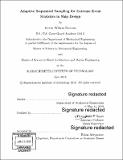Adaptive sequential sampling for extreme event statistics in ship design
Author(s)
Stevens, Kevin Wilson
DownloadFull printable version (12.57Mb)
Other Contributors
Massachusetts Institute of Technology. Department of Mechanical Engineering.
Advisor
Themistoklis P. Sapsis.
Terms of use
Metadata
Show full item recordAbstract
For more than a century, many facets of ship design have fallen into the domain of rules-based engineering. Recent technological progress has been validated to the point that many of these areas will soon warrant reconsideration. In this emerging environment, accurately predicting the motions and loading conditions which a ship is likely to encounter during its lifetime takes on renewed importance. Even when the wave elevations a ship encounters are governed by normal (Gaussian) statistics, the resulting motions and loading conditions can deviate substantially due to the nonlinear nature of the ship dynamics. This is sometimes manifested by heavy tailed non-Gaussian statistics in which extreme events have a high probability of occurrence. The primary method for quantifying these extreme events is to perform direct Monte-Carlo simulations of a desired seaway and tabulate the results. While this method has been shown to be largely accurate, it is computationally expensive and in many cases impractical; today's computers and software packages can only perform these analyses slightly faster than real time, making it unlikely that they will accurately capture the 500 or 1,000-year wave or wave group even if run in parallel on a large computer cluster; these statistics are instead extrapolated. Recent work by Mohamad and Sapsis at the MIT Stochastic Analysis and Non- Linear Dynamics (SAND) lab has identified a new approach for quantifying generic extreme events of systems subjected to irregular waves and coupled it with a sequential sampling algorithm which allows the accurate results to be determined for meager computational cost. This thesis discusses the results of applying this approach directly to ship motions and loading conditions using a modified version of the Large Amplitude Motions Program (LAMP) software package. By simulating the ship response for a small number of wave-groups (order of 100) we assess the accuracy of the method to capture the tail structure of the probability distribution function in different cases and for different observables. Results are compared with direct Monte-Carlo simulations.
Description
Thesis: S.M., Massachusetts Institute of Technology, Department of Mechanical Engineering, 2018. Thesis: S.M. in Naval Architecture and Marine Engineering, Massachusetts Institute of Technology, Department of Mechanical Engineering, 2018. Cataloged from PDF version of thesis. Includes bibliographical references (pages 103-105).
Date issued
2018Department
Massachusetts Institute of Technology. Department of Mechanical EngineeringPublisher
Massachusetts Institute of Technology
Keywords
Mechanical Engineering.